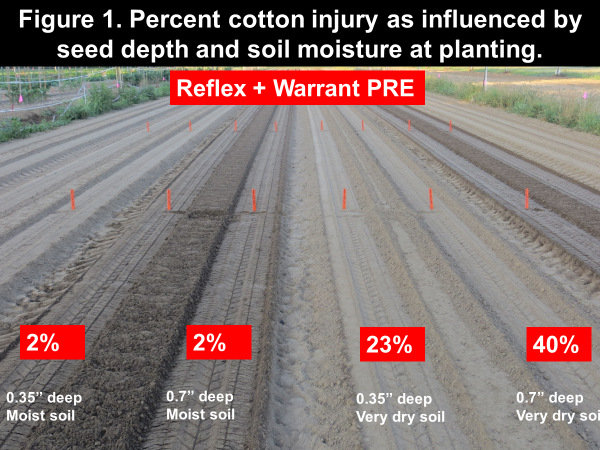The most effective approach to minimize cotton injury from preemergence (PRE) herbicides is to place the cotton seed in moist soil where it can imbibe (absorb) clean water free of herbicides (Figure 1). Next, we need our cotton roots to “out run” the herbicide as the herbicide is moving down into the soil with rainfall or irrigation. When placing cotton seed in dry soil and then applying a PRE herbicide, it is likely impossible for water to get to the seed without being contaminated with the herbicide causing a much greater potential for injury.
Thus, dusting cotton in and applying PRE herbicides is far from ideal in regards to avoiding cotton injury. The next thought from every grower, is to hold off on the herbicides until the cotton emerges. This thought is extremely dangerous when considering the monumental challenges our family farms face with herbicide resistance in Palmer amaranth. However, it may be the only option in some environments. If one does follow the path of not using PRE herbicides and planting cotton into dry soils, there are several key points to consider.
First, there needs to be no weeds emerged (especially Palmer) when the cotton seed is placed in dry soil. If there is, get the backhoe out to dig the Palmer up later in the year. In theory, if the field is weed-free when dusting cotton in the soil then no additional weeds should emerge until it rains.
Second, the first postemergence herbicide application should occur as soon as the cotton is fully emerged; the treatment must kill emerged weeds and must include residual herbicides. The level of selection pressure placed on the postemergence herbicide in this situation is very high and not sustainable in time.
Third, a second postemergence herbicide application should be made 12 to 15 days later and again include a residual product, this timing assumes you were timely with the first postemergence application. If you were not timely, the interval needs to be tightened down following label recommendations.
And finally, the value of the layby application in fields without a PRE increases astronomically in regards to herbicide sustainability. Although it is time consuming, it is still better than pulling pigweed!

